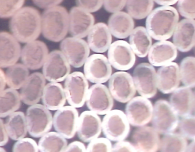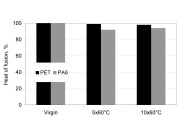Thermal comfort is dependent upon both environmental and individual factors and is influenced by the core and skin temperatures of the body. The thermo-neutral zone for naked resting subjects has been defined as between 28-30°C. In this comfort zone the human body is unaware of warmth or coolness. Outside this range the body feels discomfort. This means that the balance between the rates of heat loss and heat generated must be maintained, usually by putting on or taking off clothes.
Clothing that could accomplish this balance is a clear advantage, and the subject of much research and new product development. The objective of a research project lead by Swerea IVF has been to develop novel temperature-regulating fibers and innovative textile products for thermal management and improved comfort. This was achieved by incorporating a phase change material (PCM) into the textile fiber itself. When the temperature increases, the PCM melts and absorbs the heat from the body in the form of latent heat, creating a cooling effect. When the temperature drops, the PCM crystallizes and the stored heat is released again for a warming effect.
The technology used

PCMs were successfully integrated into meltspun textile fibers by means of bi-component sheath/core technology. In this way the PCM is permanently trapped inside the core of the fibers. For improved thermal management, polyamide (PA6), polyester (PET) and polylactide (PLA) filament yarns were produced as well as staple fibers. Different PCMs with melting points in the range 28-45°C were used and the heat of fusion of the resulting fibers was about 60 J/g based on total yarn weight. This is significantly higher than state-of-the-art viscose and acrylic yarns with a microencapsulated PCM, showing latent heats in the range 5-15 J/g. The fibers are of sufficient strength for use in garments and other products. The use of PA6, PLA and PET ensure that the PCM will not leak out from the fibers during use and repeated washing cycles.
In order to produce fibers with a PCM/polymer alloy core it is necessary to apply certain proprietary precautions and modifications to the extrusion equipment. Investment in the range of 100 000 – 200 000 € is needed for converting an existing standard industrial bi-component extrusion line.
Finishing and dyeing, washing
Following the finishing procedures, there is no evidence of significant latent heat loss in comparison with the untreated reference. A lower dyeability has been observed in the case of both PET and PA6 yarns with PCM as compared to the corresponding yarns without PCM. The fabric with PCM content displays lighter colors compared to a reference without PCM content. This is expected since the hydrophobic fiber cores will not pick up any dyestuff. The dye will be confined to the PET or PA6 sheath. This effect thus needs to be considered in deciding on the dyeing prescription. The presence of PCM in the fiber has no negative influence on the dyeing fastness; good color fastness to washing, acid or alkaline perspiration and very good fastness to dry and wet rubbing was found.
Fibers with PET and PA6 in the sheath show only a slight loss of PCM after 5 and 10 washing cycles at 60°C.
Important to consider

The endurance of the cooling (or heating) effect is proportional to the weight of PCM applied and thus to the gram weight (g/m2) of the fabric. There is thus a compromise between the thermal efficiency and garment weight that has to be made. Once the PCM in the fabric is molten or solidified the thermal effect ends. Suitable applications thus rely on periodically changing conditions, either in physical activity or in environmental conditions.
One should critically examine each application to see if the PCM can bring real value. Much of the existing state-of-the-art use of PCMs in garments is more of a marketing gimmick than presenting real perceived value to the user. By using products with higher latent heat values (J/g) the chances will, of course, be better. Still, a critical assessment in each case is strongly recommended.
Swerea IVF is a part of Swerea Group, a Swedish research institute. It provides advanced research and consulting services to the manufacturing and product development industry, with the goal of rapidly bringing new technologies and new methods into practical use.
 TEXTILES.ORG
TEXTILES.ORG


